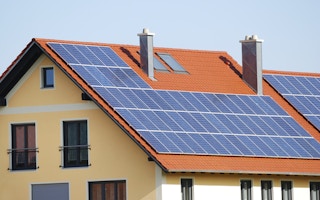Renewable energy investment is set for a turnaround this year with sales of green bonds rising to a record, according to the head of Bloomberg New Energy Finance.
Onshore wind’s resurgence and spending on solar power may also drive investment to about $300 billion, after a two-year slide, said Chief Executive Officer Michael Liebreich. Green bonds for environment and clean-energy ventures may reach about $20 billion, after last year’s record of $14 billion, he said.
“For over a hundred years the orthodox view of the energy system prevailed,” the CEO of the research firm said. “Power generation was big, dirty and central. Grids were centralised and dumb. For some years now we have been saying that this orthodoxy is not going to hold. I predict 2014 is going to be the year when this becomes starkly obvious to most people.”
The industry’s starting to reap the benefits of a decade of investment. Solar and wind costs are closing in on conventional sources even without subsidies, garnering the attention of debt investors seeking long-term returns from electricity contracts. It’s also shifting from European and North American markets to nations such as South Africa, Brazil and Mexico, Liebreich said.
“
Green bonds for environment and clean-energy ventures may reach about $20 billion, after last year’s record of $14 billion
Michael Liebreich, Bloomberg New Energy Finance CEO
China and Japan will drive as much as 51 gigawatts of solar installations this year, he said in a statement from the London-based researcher outlining 10 industry forecasts for this year. Solar producers are returning to profit on modest increases in equipment prices after a supply glut led to bankruptcies. China was probably the top solar market last year, Liebreich said.
Subsidy Free
Photovoltaic farms built without subsidies will increase as Europeans install systems on rooftops and villages, islands and remote facilities use standalone projects, he said. Total SA, Europe’s third-biggest energy company, in September said it was planning the largest unsubsidized solar farm in Chile’s Atacama desert. Conergy AG also developed projects in Spain without aid.
Offshore wind farms in Europe to be commissioned from 2016 may get funded in 2014 and BNEF sees onshore gigawatts doubling in Brazil, South Africa, Mexico, Chile, Uruguay and Japan.
A key question will be whether the production tax credit incentivising US wind power that expired at the end of 2013 is reinstated. Legislation supporting it is only likely if attached to other business-tax credit extensions, Liebreich said. Congress will likely not act on the credit until after the November elections, he said.
Electric Cars
Green bonds will continue funding ventures, adding downward pressure on lending costs, he said. His comments echo those of Michael Eckhart, Citigroup Inc’s head of environmental finance, who said sales of the securities are set to expand after bank lending fell. Last year’s $14 billion record will probably be topped, with $860 million in issuances already this month from the European Investment Bank, according to Liebreich.
Growth of electric vehicles will slow to 50 per cent, with 300,000 units sold around the world in 2014, from 100 per cent growth last year, as the young market faces supply constraints and early adopters already made purchases, he said.
Tesla Motors Inc and Bayerische Motoren Werke AG are at full capacity, with order backlogs, for some models, he said. Sales this year will show electric vehicles are making their way through the “credibility barrier.”
Investment in smart grids will hold at about $15 billion as a Chinese investment program peaks and Brazilian regulations to aid rolling out the technology fail to have the desired effect. Growth in the systems, which enable consumers and utilities to gauge and respond to power use, will come from Europe and Japan.
Liebreich expects more data on shale-gas drilling prospects from outside the US such as Mexico and China. The emerging UK hydraulic fracturing market will continue to be plagued by “trench warfare” between producers and anti-shale activists.










